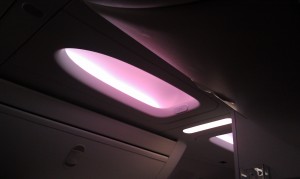
For 17 years, I have qualified to be a sardine.
That is to say that — since some time in 1996 — I have so often tightly packed my 6’4″ self into winged metal containers filled with people that I have qualified for MVP Gold status on Alaska Airlines every year. “Sardine” is one of the many terms of endearment those of us who are not George Clooney use to describe, on group hug sites like FlyerTalk, what we have to go through to reach very frequent flier status.
Which is why, when someone from Alaska Airlines called and said, “Do you want to spend your Friday flying from Paine Field in Everett to Seattle Tacoma International Airport,” I jumped at it. Because I am an obsessive sardine.
The occasion? Alaska taking delivery of its very first 737-800 with Boeing’s cutting-edge Sky Interior.
Now before you yawn, let me say that even if you’re not a very frequent flier, this is damned exciting. Because it literally changes your perspective on the real estate airline travelers call home for anywhere from two to six hours at a time.

The Sky Interior was originally developed for Boeing’s 787 Dreamliner (I recall seeing a mock up, years ago, at a Boeing “showroom” in Tukwila). It proved so intriguing to airlines that Boeing adapted it for new 737 orders. Since October 2010, more than 200 “Next Generation” 737s have been delivered with the interior, including to Continental (now merged with United) and American (now merged with U.S. Bankruptcy Court).
The most obvious improvement? The passenger cabin simply appears larger, with more headroom.

The visual tricks Boeing has used include sloping the overhead bins so they follow the curve of sculpted cabin walls and pivot down to open (holding more luggage, too), and shaping the window recesses so they draw your eyes to the outside. Even buttons for reading lights have been re-designed to make it easier to not annoy flight attendants by accidentally hitting the call button.
And there are wonderfully geeky details. Large, recessed oval ceiling panels lit with color LEDs ( light emitting diodes) and color LED sidewall lighting give off a futuristic glow reminiscent of science-fiction movies like 2001: A Space Odyssey.
Alaska will use the standard sky blue for daytime flights, but switch to a pinkish “sunrise/sunset” palette for night departures, and a very dark blue scheme for taxi, takeoff and landing instead of turning all the cabin lights off. Flight attendants can control the nine standard and four Alaska-custom light settings from a touchscreen panel.
One of the less obvious techie improvements, notes Alaska’s Manager of Product Development Chase Craig, is a type of “flight attendant assist” on the luggage bins. If there’s more than 80 pounds of luggage in a bin, an attendant can simply flip a lever on the side, pull down on the bin instead of pushing up, and the bin will spring closed. It’s essentially a reverse-hydraulic assist.
And those announcements on overhead speakers that are generally less understandable than a fast-food attendant’s request? The Sky Interior replaces them with better speakers in every passenger row.
In order to get the full effect, we boarded our Alaska 737-800 (tail number N536AS for aviation geeks) at Paine Field for the short delivery flight to the jet’s new home at Alaska’s SeaTac hanger.

One of the first things I noticed when taking my window seat is that I could easily see the ceiling in the aisle at my row – a sight normally obscured by luggage bins in the older 737 interiors. The ceiling coves, LED illumination and sloping bins and sculpted walls did provide an unexpected feeling of dimensionality, as if the cabin had more space to explore than it really did.
It’s not like Alaska is a newbie to tech innovation. Though slightly late to the Sky party, Alaska has a long history of doing geeky stuff. The first to sell tickets on the web. The first with web check-in. Among the first to have check-in kiosks and possibly first with last-minute web specials (famously called by former marketing veep Steve Jarvis the airline’s “brown bananas”). And the first to have a portable digital video player onboard, the DigEPlayer.
Alaska plans to take delivery of five more 737s with the Sky interior between now and the end of the year, for a total of three 737-800s and three 737-900ERs. No word on what flights the first Sky is likely to fly, but odds are it will be where a passenger would expect to see a 737-800 – on a transcontinental or Hawaii route.
I have not yet dared to ask how many frequent flier miles I earned.



